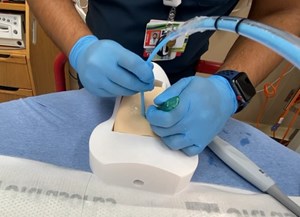
PMAM Section Resolutions at the 2022 Council Meeting
There were 5 different resolutions passed at the 2022 Council Meeting with relevance to our section. One of our section objectives is to: “Provide guidance and support to assist emergency physicians in helping patients with opiate addiction and referral to detox and rehabilitation”.
All 5 resolutions relate to this very important objective. The pain management addiction medicine section introduced three of the resolutions, but two were introduced by other College members. Drs. Don Stader and Eric Ketcham worked hard during the Council meeting to get these passed. The resolutions were initially discussed in different reference committee rooms, so these gentlemen ran from room to room to support these resolutions. The resolutions were then discussed in the full Council meeting and several our section members spoke eloquently to support these. ACEP is currently working on implementing these resolutions.
Resolution 29: Buprenorphine is an Essential Medicine and Should be Stocked in Every ED
Introduced by the PMAM Section et al.
- RESOLVED, That ACEP advocate on behalf of its patients and members that the FDA add buprenorphine to its list of essential medications; and be it further
- RESOLVED, That ACEP recommend and advocate that every emergency department stock buprenorphine and medications for opioid use disorder so that patients with opioid use disorder or in opioid withdrawal may receive the best evidence-based care; and be it further
- RESOLVED, That ACEP work with the American Hospital Association, American Medical Association, state agencies, and federal agencies to promote availability of medications for opioid use disorder in emergency departments and hospital settings; and be it further
- RESOLVED, That ACEP support hospitals and emergency physicians in initiating treatment protocols for opioid use disorder and opioid withdrawal using buprenorphine and medications for opioid use disorder to enhance best evidence-based practices in emergency medicine throughout the United States.
Implementation Action: It has been assigned to Advocacy & Practice Affairs staff for federal and state advocacy initiatives.
Resolution 32: Supervised Consumption Facilities/Safe Injection Sites
Introduced by Drs. Larry Bedard and Dan Morhaim
- RESOLVED, That ACEP support the development and implementation of Supervised Consumption Facilities/Supervised Injection Sites (SCF/SIS) in the United States that would be designed, monitored, and evaluated to include additional data to inform policymakers on the feasibility, effectiveness, and legal aspects of SCF/SIS in reducing harm and health care costs related to injection drug use.
Implementation Action: It has been assigned to the Public Health & Injury Prevention Committee to develop a policy statement in support of supervised consumption facilities/supervised injection sites.
Resolution 33: Telehealth Bridge Model for the Treatment of Opioid Use Disorder
Introduced by Pennsylvania Chapter of ACEP
- RESOLVED, That ACEP support the development and implementation of low-barrier telehealth medication treatment services to address gaps in opioid use disorder care; and be it further
- RESOLVED, That ACEP advocate for state and federal regulatory and legislative solutions that will permit the ongoing integration of opioid use disorder treatment including medication therapy through telehealth into the continuum of addiction care.
Implementation Action: it has been assigned to Advocacy & Practice Affairs staff for federal and state advocacy initiatives and consult with the Emergency Telehealth Section.
Resolution 41: Addressing Stigma in the Emergency Department
Introduced by PMAM Section
- RESOLVED, That ACEP develop an educational program on identifying and addressing stigma in the emergency department that can be provided to residency programs as a standard part of residency training, highlighting the role of important practices such as person-first language.
Based on Council Testimony and Council Reference Committee recommendation the Council and the Board adopted the Amended Resolution 41(22):
- RESOLVED, That ACEP develop an educational resource on identifying and addressing stigma in the emergency department that can be provided to emergency physicians and residency programs, highlighting the role of important practices such as person-first language.
Implementation Action: It has been assigned to the Public Health & Injury Prevention Committee to develop an educational resource and work with the Pain Management & Addiction Medicine Section and the Social Emergency Medicine Section. Seek input from EMRA and CORD regarding the type of resource that is needed. Review the Substance Use Disorder Emergency Medicine Residency Curriculum that was developed by ACEP, ABEM, CORD, and EMRA and recommend revisions to the curriculum if needed.
Resolution 43: Endorsing ED Resident Competency in Buprenorphine Initiation
Introduced by PMAM Section
- RESOLVED, That ACEP support the integration of buprenorphine training and harm reduction skills into the core curriculum for residents graduating from Accreditation Council for Graduate Medical Education accredited emergency medicine programs; and be it further
- RESOLVED, That ACEP coordinate with other organizations in emergency medicine (Council of Residency Directors in Emergency Medicine, Society for Academic Emergency Medicine, and the American Board of Emergency Medicine) to further endorse integration of buprenorphine training and harm reduction skills into curriculum or simulation sessions during residency and should focus on identification of patients with opioid use disorder and initiation of buprenorphine treatment as well as sharing harm reduction information and resources such as clean syringes, naloxone, and fentanyl test strips, depending on local practice and availability.
Based on Council Testimony and Council Reference Committee recommendation the Council and the Board adopted the Amended Resolution 43(22):
- RESOLVED, That ACEP support the integration of buprenorphine training and harm reduction skills into the core curriculum for residents graduating from Accreditation Council for Graduate Medical Education accredited emergency medicine programs; and be it further
- RESOLVED, That ACEP coordinate with other organizations in emergency medicine (Council of Residency Directors in Emergency Medicine, Society for Academic Emergency Medicine, and the American Board of Emergency Medicine) to further endorse integration of buprenorphine training and harm reduction skills into curriculum or simulation sessions during residency and should focus on identification of patients with opioid use disorder and initiation of buprenorphine treatment as well as sharing harm reduction information and resources.
Implementation Action: It has been assigned to the Academic Affairs Committee to develop strategies to address the resolution and seek input from EMRA.
The PMAM Section is to be congratulated for our success at the 2022 Council Meeting. We certainly moved ACEP to further action on addiction medicine. The Pennsylvania Chapter and Drs Larry Bedard and Dan Morhaim are other leaders who promoted the cause of addiction medicine at the Council meeting. Finally, I would be remiss for not commending the Council for recognizing the importance of these resolutions and passing them! We all worked in the best interest of our patients.
Respectively submitted by
John Bibb, MD, FACEP



